The Norse people were the ancient tribal communities of Scandinavia, who in the modern day are often referred to or thought of as the Vikings (who were actually a subset of them). Like many other ancient communities, they had their own ideas about how the earth and the universe were created.
The Sources of the Norse Creation Myth
Our understanding of the Norse creation myth comes from a small number of sources. The most useful of these were created in the medieval period, and therefore do not come from the time when Scandinavian people were telling these myths. Thus, they must be taken with a pinch of salt.
This is for a number of reasons. Later authors could have easily added information themselves, or because many of these stories were not ever written down but rather passed on through word of mouth, they may have changed multiple times as they were passed down.
Despite this, scholars tend to assume the myths that we have today share many of the same elements and basic structures of the originals. Not only have they assumed so because of physical evidence left, like artwork, but also from the similarities between Norse myths and other European and Near East creation myths.
While these similarities may very well be the product of medieval writers making their own additions to the original Norse stories, scholars are fairly confident that the similarities demonstrate a shared origin of all these myths.
For example, there are figures similar to the Christian Adam and Eve in the Norse creation myth. The Egyptian goddess Hathor was often pictured with a cow, similar to the goddess Hera from ancient Greek myths. Norse mythology depicts Ymir being nursed by a cow, while in Greek mythology, Zeus is nursed by a goat.
Another common theme is murder of the previous ruler. This is something that happens in Norse mythology, as well as in other European myths, like the Irish Tuatha De Dannan , who conquers the Fir Bolgs and Fomorians. There are also the myths of Cronus and Uranus, where this theme is present.
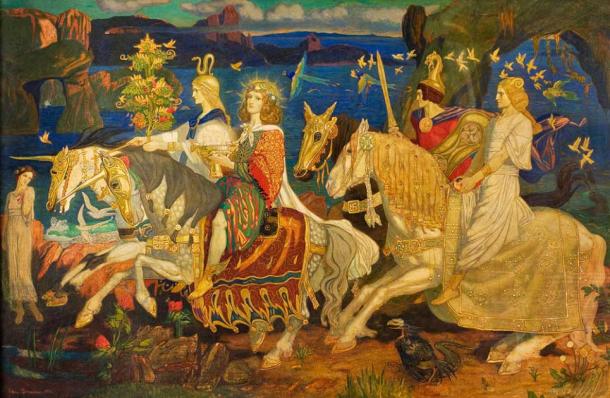
There are interesting similarities between the Norse creation myth and other worldwide creation myths. The Tuatha Dé Danann as depicted in John Duncan's Riders of the Sidhe, 1911 (SevenSeaOcean / CC BY SA 4.0 )
World Building According to the Norse Creation Myth
According to the Norse creation myth, in the beginning, there was nothing. This void of darkness was given the name Ginnungagap. Eventually, two other realms came into existence and were given the names Niflheim and Muspelheim.
Niflheim was located in the north and was characterized by extremely cold weather and eternal darkness. It was thought to have been the realm of ice, with nothing there but frost and fog. Muspelheim, on the other hand, was known for its fire and extreme heat. There was nothing there but lava and smoke. It eventually became the home of the fire giant Surtr, who was eventually accompanied by fire demons and other fire giants.
In Ginnungagap, it was also said that there was a spring (or well depending on the source) which was given the name Hvergelmir. From this spring, freezing cold rivers were formed. These rivers were collectively named Elivagar, which meant ‘ice waves’. It was the water from this source that also fed Yggdrasil, the world tree.
According to some records of the creation myth, the water from these rivers flowed across Ginnugagap and through its desolate mountain ranges. There they solidified into ice and formed layers upon layers of frozen wasteland.
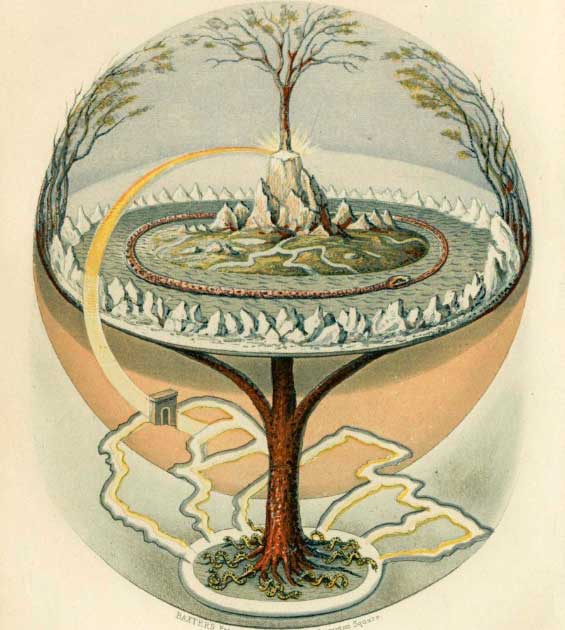
According to Norse mythology, a spring in Ginnungagap fed the world tree Yggdrasil ( Public Domain )
The First Beings in Norse Creation Myth
According to Norse mythology, the first beings to occupy this desolate, dark wasteland were giants. The first giant was given life when sparks from the extremely hot Muspelheim flew into Ginnungagap. The lava and the spark from Muspelheim began to melt the ice that had come from Niflheim.
Eventually, one block of ice began to melt away, revealing the form of a man. This would be the first jotunn (or giant), and he was given the name Ymir. Ymir then gave life to other beings, for when he fell asleep, two more giants grew from his sweat.
One of these new giants was a female and the other a male; from the rest of Ymir’s sweat came their child Thrudgelmir. The three formed the first family of giants. These early giants were sustained by breastfeeding from a cow named Audhumbla, who had also been formed from the melting ice in Ginnungagap alongside Ymir.
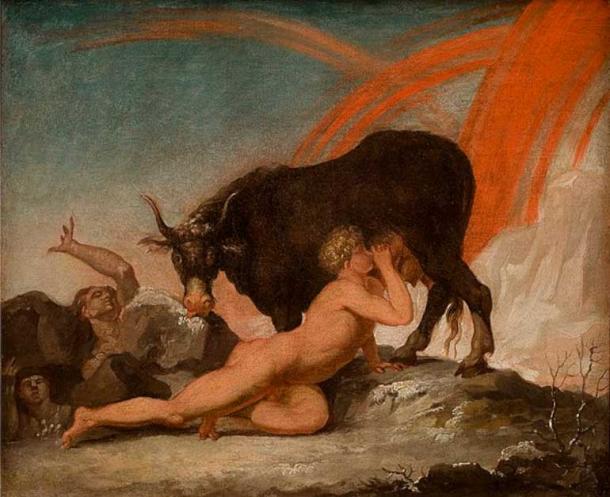
In the Norse creation myth, Ymir suckled the cow Audhumbla at the dawn of the gods. Painting by Nicolai Abildgaard, 1777 ( Public Domain )
These giants and the cow, Audhumbla, were the creators of all other beings. Audhumbla sustained herself by licking a salty rock or block of ice. She licked and licked, until one day a human man emerged from the rock. This man would be the first god and was given the name Buri. Buri was said to be big and handsome, and would eventually take a wife by the name of Bestla and produce a son named Borr.
According to some sources, in an interesting turn of events, Borr and Bestla then reproduced and had children of their own. In other versions of the myth, Bestla was Buri’s daughter, and in yet others, she was a frost giant who was also formed from Ymir’s sweat.
Regardless of their family history, these children were named Odin, Vili and Ve, the first of which would go on to become the king of the Norse gods and rule over Asgard.
While all this was happening, the first giant Ymir continued to live. However, over time he became violent, and Odin, Vili and Ve decided they needed to be rid of him. Furthermore, the giants had kept reproducing, which meant they now outnumbered the gods, which was another issue the brothers wanted to solve.
The logical solution to this issue, according to Odin and his brothers, was to kill Ymir. However, because Ymir was a powerful giant, they didn’t like their chances and so waited until he was asleep to attack him.
A huge battle broke out between the brothers and Ymir, but the brothers managed to gain the upper hand and kill the giant. His blood spurted everywhere violently and ended up drowning most of the other giants. Only two were said to have survived (Bergelmir and his wife), and they fled to a faraway land and continued the giant race.
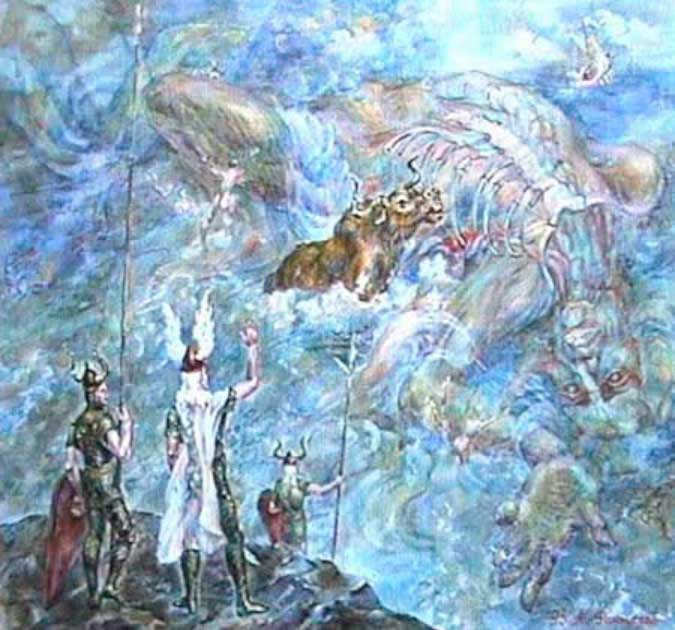
Odin, Vili and Ve killed Ymir and created the world of Midgard from his body (Sokol_92 / CC BY SA 3.0 )
The Creation of Earth in the Norse Creation Myth
From Ymir’s death came life, however, as his remains were used to form Earth. The three gods dragged Ymir’s body back to Ginnungagap where it remained forever and became the Earth. The blood that was still flowing from his body became the sea and rivers, and his bones and teeth became the mountains.
His skull became the sky and his brain the clouds. Odin and his brothers took some of the sparks from Muspelheim and threw them into the sky in order to create the stars. The gods also built Asgard, the realm of the gods and a place named Jotunheim where the giants could live.
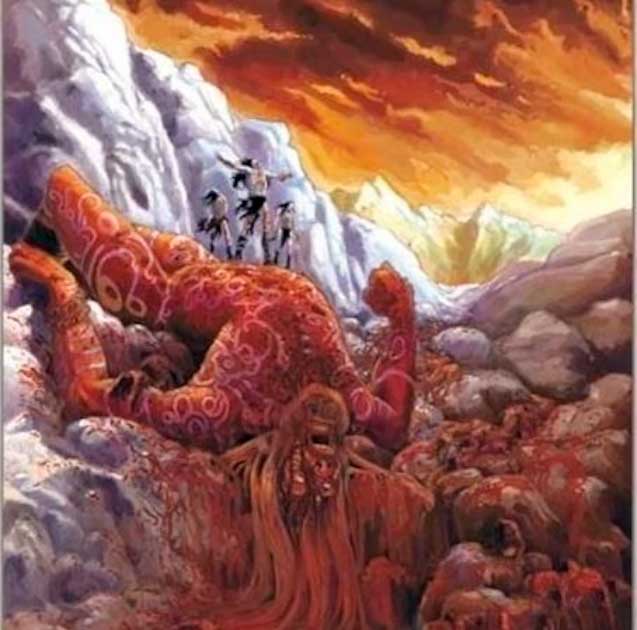
After Odin and his brothers killed Ymir in the Norse creation myth, rivers of blood enable human life to arise (PlasmaCommentates / CC BY SA )
In order to protect this new world from the threat of the giants, the brothers used Ymir’s eyebrows to build a protective wall around this new land. This new world was given the name Midgard (Middle Yard) as it was in the center of the Yggdrasil.
There were not only giants and men in this new world, but also dwarves. They were said to have formed from the worms that were crawling in and out of the decaying remains of Ymir’s body. Four of these dwarves were tasked by the gods to go to the four corners of this new world and hold up the sky, for they were scared that it would fall down. These four dwarves were given the names Nordi, Vestri, Sundri and Austri (North, West, South, East).
The remaining dwarves made their homes in the rocks and caves. Their home was eventually given the name Svartalheim. They were known as experts in craftsmanship and were responsible for making Thor's famous hammer, Mjolnir.
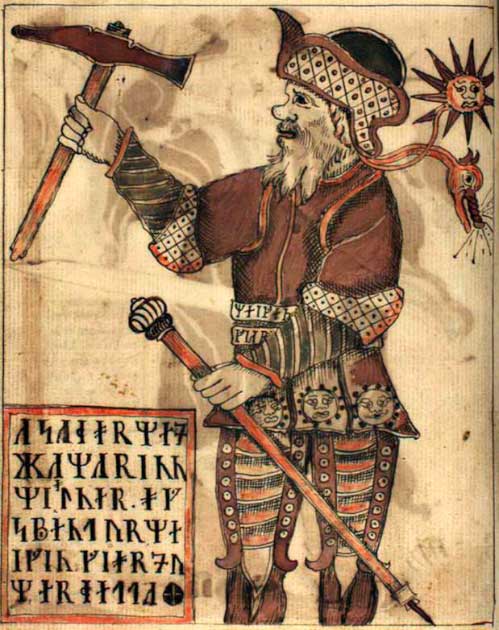
Thor with his hammer Mjolnir, forged by dwarves in Svartalheim, from an 18th century Icelandic manuscript ( Public Domain )
The first human men were created by Odin and his brothers. They went to a beach, where they found two logs; one was ash and the other was elm. In other sources, the gods took branches from the world tree and used these instead.
Using his powers, Odin breathed life into the logs, Ve gifted them movement and intelligence, and Vili gave them their shape alongside their speech and emotions.
These logs took the form of the first man and first woman. The man was named Ask and the woman Embla. The Gods then placed the pair in Midgard where they carried on the human line.
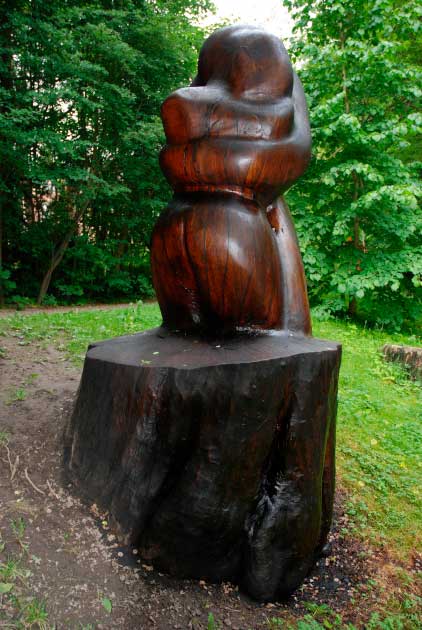
Carving of Ask and Embla, the first humans (Bengt Oberger / CC BY SA 3.0 )
The Gods of Norse Creation Myth
The gods then went to live in their realm, Asgard. Nothing else is recorded of Vili and Ve, but Odin went on to become the ruler of the Aesir gods and married the goddess of marriage and family, Frigg.
Eventually, another tribe of gods named the Vanir would form and live separately from the Aesir gods in Vanaheim. Historians tend to believe that these two tribes represent two different Norse cultures. The Aesir were the gods of the Germanic people and the Vanir of people in Scandinavia. The Germanic people were those who moved into Norway and Demark.
The continual cycles of fighting and then peace between the Vanir and the Aesir is thought to have been representative of the relationship between these two groups. Although they battled at first, they eventually became intermingled and created one group.
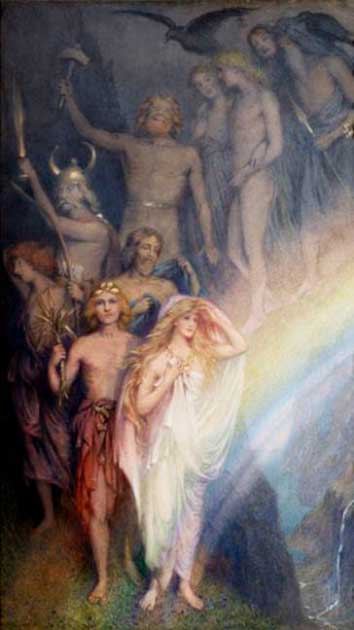
The Aesir and Vanir gods may have represented two distinct Norse cultures. Painting, The Northern Gods Descending, by W.G Collingwood, 1890 ( Public Domain )
The Creation of the Sun and the Moon and of Night and Day
The sun and moon were created when a man named Mundilfari had two children whom he named Mani and Sol (Moon and Sun). He gave them such names because he believed them to be so beautiful. The gods were angered by this perceived arrogance and sought to punish Mundilfari. They banished his children to the sky, where they were forced to pull a chariot, one all day and the other all night.
Sol would pull the chariot during the day and was given two horses named Arvakr and Alsvior. She was also given a shield named Svalin, which she used to shield the earth from the flaming heat. Mani was tasked with pulling the chariot at night. He was given only one horse named Aldsvider, and he stole two children from Midgard named Bil and Yuki to help him with this difficult task. Sol and Mani were chased by two terrifying wolves named Skoll and Hati. The pair managed to outrun the wolves every night, until Ragnarok.
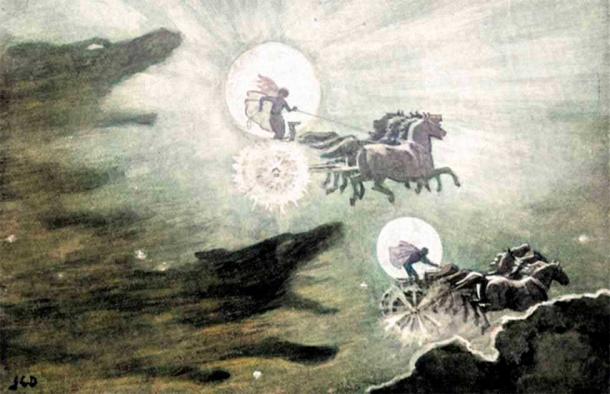
The Wolves Pursuing Norse sun and moon gods Sol and Mani, by John Charles Dollman, 1909 ( Public Domain , colorized)
The myth states that night and day were created when a giant named Norvi produced a daughter who he called Nott (Night). Nott went on to have a son, who she named Dagr (Day). The pair rode chariots like Mani and Sol; Nott’s was pulled by a horse named Hrimfaxi and Dagr’s was pulled by Skinfaxi.
The myth of day and night is confusing, however, because records state that they too were chased by the two wolves Skoll and Hati. This seems unlikely if they were also chasing the sun and moon at the same time.
To conclude, the Norse creation myth shares many common themes with other European and Near Eastern creation myths. Nevertheless, it remains interesting and provides an insight into the foundations of Norse beliefs and the stories Norse people passed on from generation to generation.
Top image: In the Norse creation myth, worlds of fire and ice emerge from the abyss at the beginning of the universe. Source: ivanovevgeniy / Adobe Stock
By Molly Dowdeswell
"creation" - Google News
December 04, 2022 at 05:00AM
https://ift.tt/ldxhGRM
Norse Creation Myth: Fire and Ice from the Abyss - Ancient Origins
"creation" - Google News
https://ift.tt/QaczCsr
https://ift.tt/XIOByE2
Bagikan Berita Ini














0 Response to "Norse Creation Myth: Fire and Ice from the Abyss - Ancient Origins"
Post a Comment